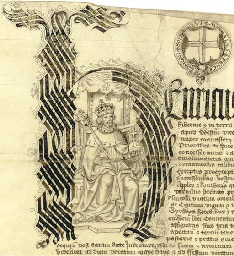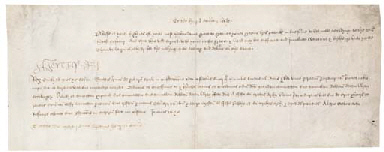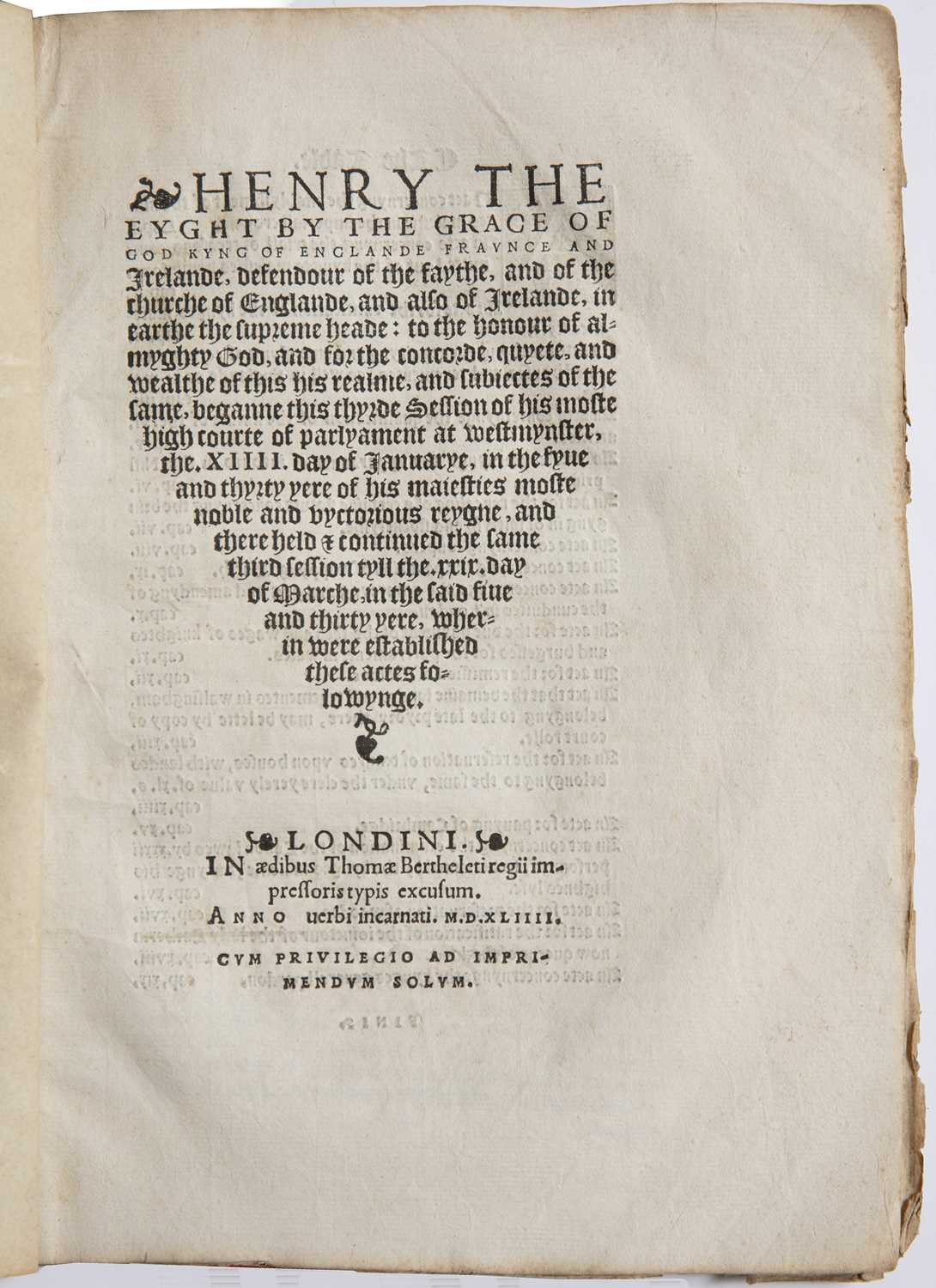Henry VIII (King of England). Assertio septem sacramentorum adversus Martinum Lutherum. Antwerp: Michiel Hillen, 1522, title within wide woodcut historiated border, woodcut initials, with final blank, later ink ownership signature to front free endpaper, ‘Ex Libris Fr: Fortescue’, marbled endpapers, 17th-century calf with roll-tooled gilt panel with fleuron corner-pieces within double fillet border, gilt-decorated spine with five raised bands, lacks spine label, rubbed, rear pastedown lifted and separated from board, a little frayed at foot of upper joint, old dark circular stain to lower board with small (20 mm diameter) hole filled in with cement paste, small 4to (198 x 135 mm) (Quantity: 1) Adams H247; PMM 50 (for first edition, 1521). First published in London by Richard Pynson in 1521, the Defence of the Seven Sacraments marks ‘a critical moment in the history of the English Reformation’ (PMM). Henry VIII dedicated the treatise to Pope Leo X, for which he earned the title ‘Fidei Defensor’ (‘Defender of the Faith’) in October 1521. The title was revoked following the king's break with the Catholic Church in the 1530s, but re-awarded to his heir by the English Parliament. Jisc Library Hub Discover cites three copies only, at Lincoln Cathedral, Chetham's and Christ’s College, Cambridge. Provenance: Sir Francis Fortescue (1563–1624) (ownership inscription); thence by direct family descent via the Turville and Constable-Maxwell lines of Husbands Bosworth Hall, Leicestershire. Francis was the eldest surviving son of Sir John Fortescue of Salden at Mursley and his wife, Cecily Ashfield. His brothers were William Fortescue and Thomas Fortescue II. In 1589, he married Grace Manners (1571-1634), daughter of Sir John Manners of Haddon Hall. In 1600, Francis became the Custos Rotulorum of Buckinghamshire and in 1608 High Sheriff of Buckinghamshire. In 1589, 1593 and 1597 he was MP for Buckingham, and in 1601 MP for Buckinghamshire. He was also an esquire of the body to Queen Elizabeth. ‘He may have been the Francis Fortescue who served in the Earl of Leicester’s train in the Netherlands. By 1596 his father was seeking on behalf of Francis and himself a grant of the bailiwick of Wychwood forest in Oxfordshire. Two years earlier, Francis had acquired a lease of three royal hundreds in Newport, Buckinghamshire. Fortescue’s marriage linked his family with that of the earls of Rutland. His father-in-law Sir John Manners not only took over the education of one of his children, but was also a candid counsellor in the years following his succession to his father, as when in 1608 he advised him ‘not to be noted as a man opposed to the King’s proceedings’. In 1612 Fortescue appears on a list of Oxfordshire recusants, ‘and most of the officers under him ... convicted recusants or non-communicants’.’ (History of Parliament online) After her husband’s death Lady Grace Fortescue, a recusant, purchased Bosworth Hall in Leicestershire, and went to live there with her son William. Since 1632 Bosworth Hall has been the home of the following families: Fortescue (1632-1763), Fortescue-Turville (1763-1900), Turville-Petre (1907-1945), Turville-Constable-Maxwell (1945 to present day), all of them Roman Catholic.
Henry VIII (King of England). Assertio septem sacramentorum adversus Martinum Lutherum. Antwerp: Michiel Hillen, 1522, title within wide woodcut historiated border, woodcut initials, with final blank, later ink ownership signature to front free endpaper, ‘Ex Libris Fr: Fortescue’, marbled endpapers, 17th-century calf with roll-tooled gilt panel with fleuron corner-pieces within double fillet border, gilt-decorated spine with five raised bands, lacks spine label, rubbed, rear pastedown lifted and separated from board, a little frayed at foot of upper joint, old dark circular stain to lower board with small (20 mm diameter) hole filled in with cement paste, small 4to (198 x 135 mm) (Quantity: 1) Adams H247; PMM 50 (for first edition, 1521). First published in London by Richard Pynson in 1521, the Defence of the Seven Sacraments marks ‘a critical moment in the history of the English Reformation’ (PMM). Henry VIII dedicated the treatise to Pope Leo X, for which he earned the title ‘Fidei Defensor’ (‘Defender of the Faith’) in October 1521. The title was revoked following the king's break with the Catholic Church in the 1530s, but re-awarded to his heir by the English Parliament. Jisc Library Hub Discover cites three copies only, at Lincoln Cathedral, Chetham's and Christ’s College, Cambridge. Provenance: Sir Francis Fortescue (1563–1624) (ownership inscription); thence by direct family descent via the Turville and Constable-Maxwell lines of Husbands Bosworth Hall, Leicestershire. Francis was the eldest surviving son of Sir John Fortescue of Salden at Mursley and his wife, Cecily Ashfield. His brothers were William Fortescue and Thomas Fortescue II. In 1589, he married Grace Manners (1571-1634), daughter of Sir John Manners of Haddon Hall. In 1600, Francis became the Custos Rotulorum of Buckinghamshire and in 1608 High Sheriff of Buckinghamshire. In 1589, 1593 and 1597 he was MP for Buckingham, and in 1601 MP for Buckinghamshire. He was also an esquire of the body to Queen Elizabeth. ‘He may have been the Francis Fortescue who served in the Earl of Leicester’s train in the Netherlands. By 1596 his father was seeking on behalf of Francis and himself a grant of the bailiwick of Wychwood forest in Oxfordshire. Two years earlier, Francis had acquired a lease of three royal hundreds in Newport, Buckinghamshire. Fortescue’s marriage linked his family with that of the earls of Rutland. His father-in-law Sir John Manners not only took over the education of one of his children, but was also a candid counsellor in the years following his succession to his father, as when in 1608 he advised him ‘not to be noted as a man opposed to the King’s proceedings’. In 1612 Fortescue appears on a list of Oxfordshire recusants, ‘and most of the officers under him ... convicted recusants or non-communicants’.’ (History of Parliament online) After her husband’s death Lady Grace Fortescue, a recusant, purchased Bosworth Hall in Leicestershire, and went to live there with her son William. Since 1632 Bosworth Hall has been the home of the following families: Fortescue (1632-1763), Fortescue-Turville (1763-1900), Turville-Petre (1907-1945), Turville-Constable-Maxwell (1945 to present day), all of them Roman Catholic.














Try LotSearch and its premium features for 7 days - without any costs!
Be notified automatically about new items in upcoming auctions.
Create an alert